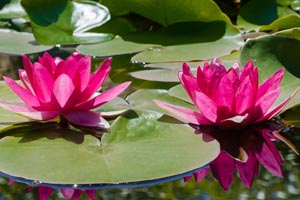Water lilies (Nymphaea spp.) are beautiful and functional additions to any landscape pool or pond. Read on to learn more.
They’re used by fish as hiding spots from predators and as shade retreats from the harsh summer heat. Plants in a pond help keep the water clean and aerated, which means you’ll spend less time maintaining it. Let’s look at how to care for a water lily. There are two varieties of water lily plants: Hardy – Hardy plants thrive in colder locations where the water freezes during the winter. Hardy individuals will emerge the next spring as long as their roots are below the freezing point of the water. Tropical — In all but the warmest climates, tropical water lilies cannot thrive in cold water and must be taken indoors for the winter. Many growers consider them annuals, replanting them every year. Otherwise, remove them from the pond before the first freeze, clean them up, and keep them in a pail of damp sand in a cool basement. Day bloomers and night bloomers are two different types of tropical water lily plants. With only the moonlight to highlight them, white night bloomers look stunning, but blues, purples, reds, and pinks are difficult to see in the dark. Unless the pond is illuminated by artificial light at night, stay away from these hues. The Best Way to Grow a Water Lily
Adjust the depth of the pot in the pond to the depth advised for your individual variety. The majority of plans ask for a depth of 6 to 18 inches (15-46 cm.). You can enhance the depth of the pot by laying it on top of rocks if necessary.
Water Lily Maintenance
Water lilies are simple to care for once they’ve been planted. In truth, most don’t take much attention other than dividing them every three or four years to avoid them from expanding into undesirable locations.
I am text block. Click edit button to change this text. Lorem ipsum dolor sit amet, consectetur adipiscing elit. Ut elit tellus, luctus nec ullamcorper mattis, pulvinar dapibus leo.
